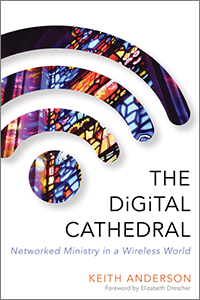Keith Anderson says our churches must get outside of our buildings, both digitally and physically, and claim a broader understanding of where faith happens.
I’m convinced that one of the major challenges for today’s church leaders is a matter of perspective. For ministry leaders, the church, whether by that we mean the building or the institution, is often at the center of our time and focus. People in parish ministry spend most of our time there, along with much of our emotional, spiritual, and intellectual energy. This is a good and noble thing. However, we can become so focused on the interworking of our congregations that we miss what is going on down the block and across our communities.
This myopia is especially dangerous in a time of institutional decline. Debates and worry over the fate of church institutions, while acknowledging the mortality of the institution, which seems a good and healthy thing, paradoxically reinforce the focus on the institution itself rather than pushing us to look beyond its boundaries. Even as the number of people present in our congregations dwindles, our fixation on the institution grows. We spend more and more time worrying over the internal operations of our institutions, even as fewer and fewer people attend and belong. Thus we inhabit and concern ourselves with an ever-shrinking piece of cultural and spiritual real estate.
Moreover, we often operate with a view of the church at the center and everything else running out into the horizon. The church is so in the foreground of our experience that everything is interpreted in relationship to the church. We see Sunday morning sports as a threat rather than an opportunity to connect with people’s daily lives. We tell a story about Nones turning their backs on the church, rather than appreciating the way in which they are making meaning and practice their spirituality. We conceive of our faith communities too narrowly, not taking into account the broad expanse of community in lived Christian experience beyond our buildings. We curse the problems with church as institution, but, because we are so stuck in that frame, we propose institutional solutions, when the problem is institutionalism itself. For many leaders, this has created a kind of ecclesiastical blind spot that renders people and places invisible to our gaze.
We need to claim a much broader understanding of who belongs to our communities and where church and faith happen. The work begins by placing ourselves outside of church buildings or ministry offices, both digitally and physically.
Rather than standing at the church door looking out, we need to be present in the places people work, live, and play, to enter into the sanctity of everyday life and understand the ways people make meaning there. We cannot define our culture, our community, or individuals from the literal or figurative perspective of the institutional church. We must put ourselves in the places where life happens. Three things church leaders can do in this new environment are connect, convene, and converse.
Connect
Ministry leaders ought to be continually on the lookout for points of connection with others. We should seek to communicate our availability to others by being present in the places where they already gather, relinquishing the instinct to define the terms of those encounters. In social media terms, we need to be “discoverable.” This means committing to a consistent presence on social media, actively seeking out local people, businesses, groups. Move some of your office hours outside the office. Get outside and spend some time on your sidewalk, whatever that place is for you in your context.
Convene
One of the most important and enduring roles of ministry leaders in the digital age is as conveners. Look for ways to bring people together. That can happen in someone’s living room, or in a coffeehouse, barbershop, or pub, on social media, or in the park. It doesn’t have to be sedentary either. Those conversations can happen while walking, running, or as I have done for men’s retreats, while climbing a high ropes course. Just bring people together, ask them to share their stories, and trust them and the work of the Holy Spirit.
Converse
Don’t just make presentations. Host conversations. Give up your predetermined theological outcomes and focus on the relationships. The leader does not need to be the center of the conversation. Instead, the task is to listen prayerfully and be attentive to the work of the Holy Spirit. Trust the process of conversation, and recognize its theological import.
 Keith is author of the recently published The Digital Cathedral: Networked Ministry in a Wireless World (Morehouse Publishing, 2015) from which this article is adapted. Used by permission. The book is available at Church Publishing and Amazon
Keith is author of the recently published The Digital Cathedral: Networked Ministry in a Wireless World (Morehouse Publishing, 2015) from which this article is adapted. Used by permission. The book is available at Church Publishing and Amazon.
Related Resources:
- Taking Church to the Community, a Lewis Center video tool kit resource
- Fostering Conversations that Connect by Lovett H. Weems Jr.
- The “Nones” and the Spirituality of Everyday Living by Keith Anderson
- Stop Complaining About Sunday Morning Sports by Keith Anderson
- Taking Prayer to the Community by Ann A. Michel







